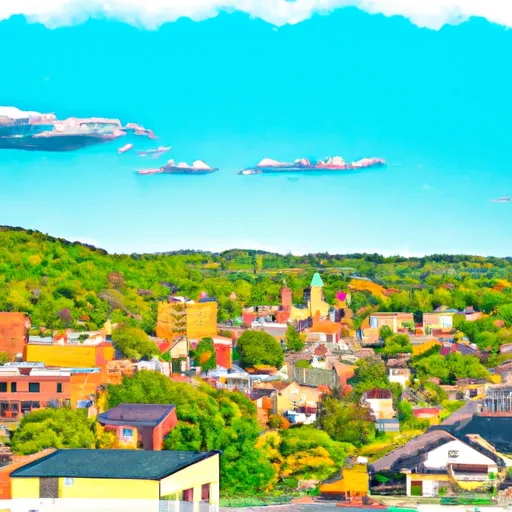-
 Snoflo Premium
Snoflo Premium
Get unlimited access to all our content
With no Ad interruptions! - Start Your Free Trial Login with existing account
Upper-Black-Eddy
Eden Index
Climate
9.3
•
Recreation
4.3
•
Community
2.0
•
Safeguard
5.7/10

Upper Black Eddy, Pennsylvania, is a scenic small town located in Bucks County. The climate in Upper Black Eddy is characterized by four distinct seasons. Summers are warm with average temperatures ranging from the high 70s to low 80s Fahrenheit, while winters are cold with temperatures typically in the mid-30s to mid-40s. Spring and fall offer mild temperatures, making them ideal for outdoor activities.
The town is nestled along the Delaware River, providing a variety of hydrology constituents. The river offers opportunities for boating, fishing, and kayaking. Additionally, the area is rich in natural beauty, with numerous creeks and streams that attract hikers, birdwatchers, and nature enthusiasts.
Outdoor recreation opportunities abound in Upper Black Eddy. Ralph Stover State Park is a popular destination for hiking, rock climbing, and picnicking. The Delaware Canal State Park offers scenic trails for walking, biking, and cross-country skiing in the winter. The nearby Nockamixon State Park provides opportunities for boating, fishing, swimming, and camping.
In conclusion, Upper Black Eddy offers a picturesque setting with a diverse range of outdoor recreational activities. Whether you enjoy water sports, hiking, or simply immersing yourself in nature, this charming town has something to offer for everyone.
What is the Eden Index?
The Snoflo Eden Index serves as a comprehensive rating system for regions, evaluating their desirability through a holistic assessment of climate health, outdoor recreation opportunities, and natural disaster risk, acknowledging the profound impact of these factors on livability and well-being.
Climate Health Indicator (CHI): 9.3
Upper-Black-Eddy receives approximately
1303mm of rain per year,
with humidity levels near 79%
and air temperatures averaging around
11°C.
Upper-Black-Eddy has a plant hardyness factor of
6, meaning
plants and agriculture in this region thrive during a short period during spring and early summer. Most
plants will die off during the colder winter months.
By considering the ideal temperature range, reliable water supplies, clean air, and stable seasonal rain or snowpacks, the Climate Health Indicator (CHI) underscores the significance of a healthy climate as the foundation for quality living.
A healthy climate is paramount for ensuring a high quality of life and livability in a region, fostering both physical well-being and environmental harmony. This can be characterized by ideal temperatures, reliable access to water supplies, clean air, and consistent seasonal rain or snowpacks.
Weather Forecast
Streamflow Conditions
Upper Delaware
Area Rivers
Upper Delaware
Snowpack Depths
Upper Delaware
Reservoir Storage Capacity
Upper Delaware
Groundwater Levels
Recreational Opportunity Index (ROI): 4.3
The Recreational Opportunity Index (ROI) recognizes the value of outdoor recreational options, such as parks, hiking trails, camping sites, and fishing spots, while acknowledging that climate plays a pivotal role in ensuring the comfort and consistency of these experiences.
Access to outdoor recreational opportunities, encompassing activities such as parks, hiking, camping, and fishing, is crucial for overall well-being, and the climate plays a pivotal role in enabling and enhancing these experiences, ensuring that individuals can engage in nature-based activities comfortably and consistently.
Camping Areas
| Campground | Campsites | Reservations | Toilets | Showers | Elevation |
|---|---|---|---|---|---|
| Tinicum County Park | None | 120 ft | |||
| Promised Land State Park | None | 1,746 ft | |||
| Lake Towhee County Park | None | 509 ft | |||
| Worthington State Forest | 70 | 321 ft | |||
| Tohickon Valley County Park | 22 | 377 ft | |||
| Ledgedale Rec Area | None | 1,183 ft | |||
| Mohican Walk-In Campsites | 7 | 927 ft | |||
| Spruce Run Recreation Area | 65 | 309 ft | |||
| Bulls Island State Park | 70 | 98 ft | |||
| Ironwood Point Rec Area - PPL | 49 | 1,296 ft |
Nearby Fishing
Nearby Ski Areas
Catastrophe Safeguard Index (CSI):
The Catastrophe Safeguard Index (CSI) recognizes that natural disaster risk, encompassing floods, fires, hurricanes, and tornadoes, can drastically affect safety and the overall appeal of an area.
The level of natural disaster risk in a region significantly affects safety and the overall livability, with climate change amplifying these risks by potentially increasing the frequency and intensity of events like floods, fires, hurricanes, and tornadoes, thereby posing substantial challenges to community resilience and well-being.
Community Resilience Indicator (CRI): 2.0
The Community Resilience Indicator (CRI) recognizes that education, healthcare, and socioeconomics are crucial to the well-being of a region. The CRI acknowledges the profound impact of these elements on residents' overall quality of life. By evaluating educational resources, healthcare accessibility, and economic inclusivity, the index captures the essential aspects that contribute to a thriving community, fostering resident satisfaction, equity, and social cohesion.

